
USS Essex (LHD-2) is a Wasp-class Landing Helicopter Dock (LHD) in service with the United States Navy. The amphibious assault ship was built at what is now Huntington Ingalls Industries in Pascagoula, Mississippi. She was launched 23 February 1991 and commissioned on 17 October 1992 while moored at Naval Air Station (NAS) North Island. She is the fifth ship named for Essex County, Massachusetts. Essex served as the command ship for Expeditionary Strike Group Seven until replaced by USS Bonhomme Richard on 23 April 2012.
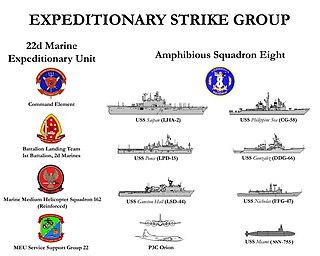
In the United States Navy, the expeditionary strike group (ESG) is a coordinated group of surface ships, aircraft, submarines, and other naval assets. In contrast to carrier strike groups (CSGs), which emphasize air power and are led by a supercarrier, ESGs are strongly suited for amphibious warfare and are led by an amphibious assault ship. The ESG concept was introduced in the early 1990s, based on the Naval Expeditionary Task Force. The U.S. Navy fields nine expeditionary strike groups.
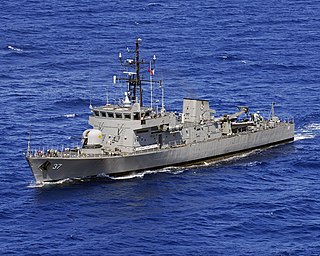
BRP Artemio Ricarte (PS-37) is third ship of the Jacinto-class corvettes currently assigned to the Offshore Combat Force of the Philippine Fleet. She is one of few ships in the Philippine Navy equipped with modern systems after the completion of combat, navigation and weapon systems upgrade of her class in August 2019. She was originally called HMS Starling (P241) during her service with the Royal Navy.

The BRP Bacolod City (LS-550) is the lead ship of two Bacolod City class logistics support vessel, and is based on a helicopter capable variant of the US Army's Frank S. Besson class. She is also considered one of the most modern transport ships in the Philippine Navy, having been commissioned during the early 1990s. She was previously known as BRP Bacolod City (LC-550) prior to a classification change implemented by the Philippine Navy starting April 2016.

The BRP Rajah Humabon (PS-11) was a former destroyer escort of the United States Navy and a former frigate of the Philippine Navy. She was the last World War II-era destroyer escort/frigate active in her fleet, and one of the oldest active warships in the world, until 15 March 2018 when she was formally decommissioned after 75 years. She was one of three ex-USN Cannon-class destroyer escorts that served the Philippine Navy, the others being BRP Datu Sikatuna (PF-5/PS-77) and BRP Datu Kalantiaw (PS-76).

The BRP Quezon (PS-70) was one of two Rizal class ships in service with the Philippine Navy. She was formerly a USN Auk class minesweeper produced during World War II, and was later on classified as a patrol corvette protecting the vast waters of the Philippines.

The BRP Rizal (PS-74) was the lead ship and first of two Rizal class ships in service with the Philippine Navy. She was an ex-USN Auk class minesweeper that was produced during World War II, and was classified as a patrol corvette protecting the vast waters of the Philippines. Along with other ex-World War II veteran ships of the Philippine Navy, she was considered one of the oldest active fighting ships in the world, until 2020.
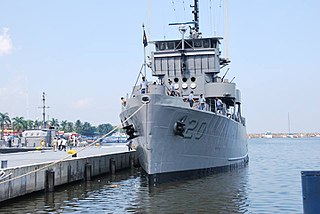
BRP Magat Salamat (PS-20) is one of several Miguel Malvar class of patrol corvettes in service with the Philippine Navy. She was originally built as USS Gayety (AM-239), an Admirable-class minesweeper with a similar hull to the PCE-842-class patrol craft produced during World War II. In 1962 she was transferred to South Vietnam for service in the Republic of Vietnam Navy as RVNS Chi Lang II (HQ-08). She was acquired by the Philippine Navy in April 1976 and later on commissioned as Magat Salamat. Along with other ex-World War II veteran ships of the Philippine Navy, she is considered one of the oldest active fighting ships in the world today.

The Jacinto-class patrol vessels currently in service with the Philippine Navy are three ships formerly belonging to the Royal Navy's Hong Kong Squadron as Peacock-class corvettes until 1997. The ships have undergone combat, electronics, weapon, propulsion and hull upgrades, with the most recent upgrade completed in August 2019. These increased their capabilities compared to the original Peacock-class vessels.

BRP Miguel Malvar (PS-19) is the lead ship of the Miguel Malvar class of corvettes of the Philippine Navy. She was originally built as USS Brattleboro PCE(R)-852, a PCE(R)-848-class rescue patrol craft escort for the United States Navy during World War II. In 1966 she was transferred to South Vietnam for service in the Republic of Vietnam Navy as RVNS Ngọc Hồi (HQ-12). She was acquired by the Philippine Navy in April 1976 and later on commissioned as Miguel Malvar after Miguel Malvar y Carpio. The ship is in active service. Along with other World War II-era ships of the Philippine Navy, Miguel Malvar is one of the oldest active fighting ships in the world today.
The BRP Datu Sikatuna (PF-5) was one of the three ex-USN Cannon-class destroyer escorts that served with the Philippine Navy, the others being BRP Datu Kalantiaw (PS-76) and BRP Rajah Humabon (PF-11).

BRP Cebu (PS-28) was a Miguel Malvar-class corvette of the Philippine Navy. She was originally built as USS PCE-881, a PCE-842-class patrol craft for the United States Navy during World War II and patrolled the Alaskan coast during that war. She was decommissioned from the U.S. Navy and transferred to the Philippine Navy in July 1948 and renamed RPS Cebu (E-28) after the Philippine province of the same name. The ship was decommissioned on 1 October 2019. Along with other World War II-era ships of the Philippine Navy, Cebu was considered one of the world's oldest fighting ships during her active service.

BRP Pangasinan (PS-31) was a Miguel Malvar-class corvette of the Philippine Navy. She was originally built as USS PCE-891, a PCE-842-class patrol craft for the United States Navy during World War II. She was decommissioned from the U.S. Navy and transferred to the Philippine Navy in July 1948 and renamed RPS Pangasinan (E-31).
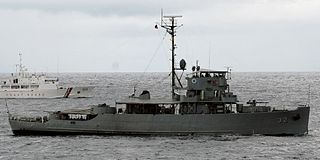
BRP Iloilo (PS-32) was a Miguel Malvar-class corvette of the Philippine Navy. She was originally built as USS PCE-897, a PCE-842-class patrol craft for the United States Navy during World War II. She was decommissioned from the U.S. Navy and transferred to the Philippine Navy in July 1948 and renamed RPS Iloilo (E-32) after the Philippine province of the same name. Along with other World War II-era ships of the Philippine Navy, Iloilo was considered one of the oldest active fighting ships in the world, being in continuous service for over seven decades.

The Rizal class was a ship class of two patrol corvettes formerly operated by the Philippine Navy. These ships were formerly used by the US Navy as Auk class minesweepers. Under the Philippine Navy, the two vessels have undergone upgrades and modification, and were categorized as corvettes.

The Bacolod City class is a ship class of two Logistics Support Vessels currently in service of the Philippine Navy, commissioned during the early 1990s. These ships were based on a helicopter capable variant of the United States Army's General Frank S. Besson, Jr. class Logistics Support Vessel.
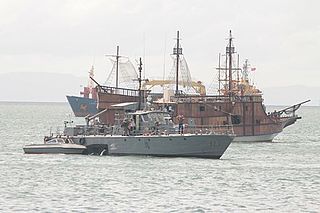
The BRP Carlos Albert (PC-375) is the fifth ship of the Jose Andrada class coastal patrol boats of the Philippine Navy. It is part of the first batch of its class ordered through US Foreign Military Sales (FMS) in 1990, and was commissioned with the Philippine Navy in January 1992. It was initially designated as Fast Patrol Craft, and was numbered "DF-375", but later on was re-designated as a Patrol Gunboat, and was re-numbered as "PG-375", until another round of reclassification changed its designation as a Patrol Craft with hull number "PC-375" from April 2016.

BRP Tarlac (LD-601) is the lead ship of her class of landing platform docks in service with the Philippine Navy. She is the second ship to be named after the Philippine province of Tarlac, one of the provinces considered to have significant involvement in the Philippine Revolution of independence against Spain.

BRP Gregorio del Pilar (PS-15) is the lead ship of her class of offshore patrol vessel of the Philippine Navy. She is the second ship to be named after Gregorio del Pilar, a Filipino revolutionary general known for his role at the Battle of Tirad Pass. She was originally designated as "PF-15" from 2012 to mid-2016. Then the Navy adopted a new code designation system and she was redesignated as "FF-15". In February 2019, the Navy downgraded the status of the entire class from frigate to patrol ship and redesignated her to "PS-15".

Robert Arugay Empedrad is a retired Philippine Navy admiral who served as the Administrator of the Maritime Industry Authority (MARINA) under the Duterte administration. He previously served as the Flag Officer-in-Command of the Philippine Navy from 2017 to 2020. He is a graduate of the Philippine Military Academy "Sinagtala" Class of 1986.






















